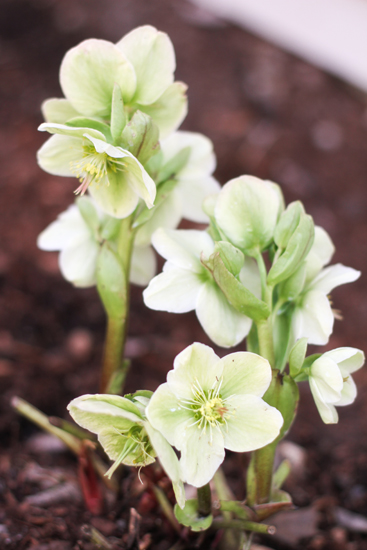Other plants than hellebores are blooming in my garden, including small bulbs like windflower anemones and scilla, but hellebores like 'Kingston Cardinal,' above, have the largest presence.
This double white was a seedling that matches my 'Sparkling Diamond,' so that's what I'm calling it. The original plant was attached by a black fungus last spring and hasn't fully recovered, though it sent up one bloom stalk this year.
This seedling seems to be a mix of red 'Velvet Lips' and 'Pink Tea Cup,' and I'm proudly calling it 'Strawberry Freckles.'
'Velvet Lips' also produced three true-to-form seedlings that bloomed for the first time this spring. I cut apart my other plants and now have eight plants in total, six of which are planted in the northwest corner.
This unnamed white hellebore was also divided into three plants and transplanted around the east back bed.
Some of my large plants didn't bloom well this spring after their buds began growing during a warm spell in February (we reached 60 degrees F one day), then the temperature plummeted to zero the next week and turned the buds to mush. This 'Golden Lotus' was one of the heavily hit plants, but the leaves are growing well so it should recover for next year.
'Jade Tiger' also lost its flower buds to the cold snap, but its leaves are beautiful on their own. They'll lighten to green later in the seasons.
A few newly planted hellebores are blooming, including 'Sweetheart Ruffles' above.
One bloom stalk on a baby 'Molly's White' is blooming. The leave are supposed to be frosted with silver, so I'm looking forward to seeing them. None of my baby 'Wedding Series' hellebores bloomed this spring, but there is a tiny bud on one of my newly planted 'Madame Lemmonier' plants.
'Amber Gem' bloomed for the first time, and it's not quite the color I imagined. That happens sometimes with seed-propagated hellebores, though the tissue-propagated plants are all identical.
And 'Pink Tea Cup' is still going strong in the front yard. It will be several years before all my baby plants and small divisions reach this size, but then the early spring show will be wonderful. As much as I love spring bulbs, they don't stay in bloom for very long. It's very nice to have hellebores that bloom for several months each year.
I'm a little late for Garden Bloggers Bloom Day (though I got my taxes done on time!), but thanks to Carol at May Dreams Gardens Blog for reminding us to take stock of our flowers each month.









































